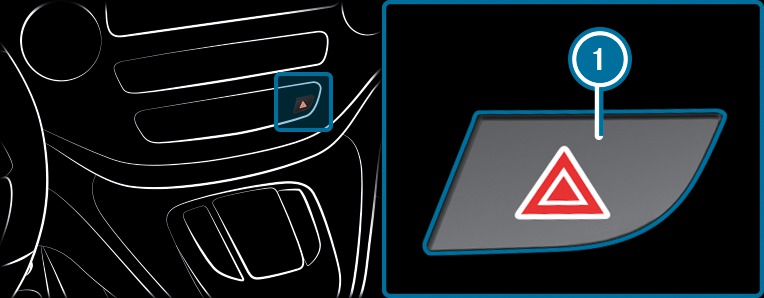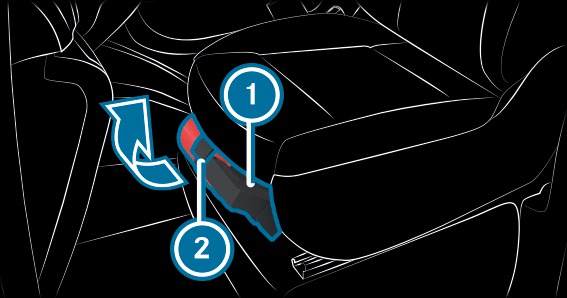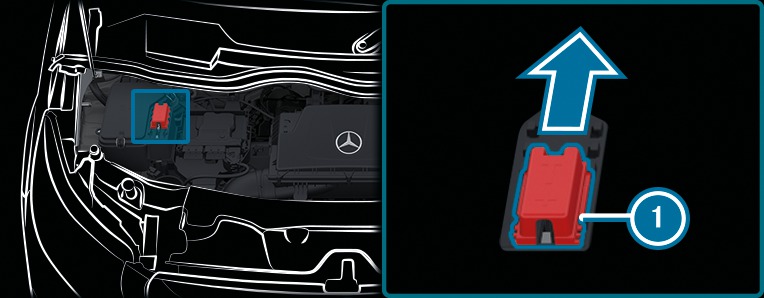
 .
. If you operate a turn signal indicator while the hazard warning light system is switched on, only the turn signal lamps on the relevant side of the vehicle will light up.
The airbag is deployed
The vehicle is heavily braked from a speed of more than 70 km/h to a standstill.
The hazard warning light system will automatically switch off when the vehicle regains a speed of more than 10 km/h after maximum full-stop braking.
The hazard warning light system will work even when the vehicle has been switched off.
A fire extinguisher may impede pedal travel or block a depressed pedal.
This jeopardises the operating and road safety of the vehicle.
The fire extinguisher can be flung around and injure the driver or other vehicle occupants.

 .
.  from its holder.
from its holder. For vehicles with a swivelling front seat, the retainer with the fire extinguisher is located at the side of the seat base.
Please read the instructions on the fire extinguisher carefully and familiarise yourself with its operation. Have the fire extinguisher refilled after each use and checked every one or two years. It may otherwise fail in an emergency.
Observe the legal requirements of the country in which you are currently driving.
The warning triangle is located in the stowage compartment in the driver's door.
The first-aid kit (soft sided) is located in the stowage compartment in the co-driver door.
Check the expiry date on the first-aid kit (soft sided) at least once a year. Replace any expired or missing contents.
Observe the legal requirements of the country in which you are currently driving.
The QR code stickers are affixed to the B-pillar on the driver's and co-driver's side. In the event of an accident, emergency services can use the QR code to quickly determine the corresponding rescue card for your vehicle. The current rescue card contains, in compact form, the most important information about your vehicle e.g. the routing of electric cables.
Further information can be obtained at Mercedes-Benz homepage - rescue card.
A discharged battery may freeze at temperatures slightly above or below freezing point.
During starting assistance or battery charging, battery gas can be released.
If the warning/indicator lamps do not light up in the instrument cluster at temperatures around or below freezing, it is highly probable that the discharged battery has frozen.
do not give the vehicle starting assistance or charge the battery
the service life of a battery that has been thawed may be reduced drastically
the starting behaviour may deteriorate, particularly at low temperatures
it is recommended that you have a thawed battery checked at a qualified specialist workshop
During the charging process and starting assistance, the battery may release an explosive gas mixture.
Battery acid is caustic.
Numerous or extended attempts to start the engine may damage the catalytic converter due to non-combusted fuel.
Do not use a rapid charging device to start the vehicle. If your vehicle's battery is discharged, the engine can be jump-started from another vehicle or from a donor battery using jump leads. For this purpose, the vehicle has a jump-start connection point in the engine compartment.
The battery is not accessible in all vehicles. If the other vehicle's battery is not accessible, starting assistance is to be provided using a donor battery or a starting assistance device.
You may only jump-start the vehicle when the engine and exhaust system are cold.
Do not start the engine if the battery is frozen. Let the battery thaw first.
Starting assistance may only be provided using batteries with a nominal voltage of 12 V.
Only use jump leads that have a sufficient cross-section and insulated terminal clamps.
If the battery is fully discharged, attach the donor battery for a few minutes before attempting to start. This charges the discharged battery a little.
Make sure that the two vehicles do not touch.
Jump leads and further information regarding starting assistance can be obtained at any qualified specialist workshop.
The jump leads are not damaged.
Parts of the terminal clamps which are not insulated do not come into contact with other metal parts while the jump leads are connected to the battery.
The jump leads do not touch moving parts when the engine is started and while it is running, such as the V-belt pulley or the fan.
 .
. 
 of the jump-start connection point towards the rear of the vehicle against the spring pressure as far as it will go.
of the jump-start connection point towards the rear of the vehicle against the spring pressure as far as it will go. The jump-start connection point is visible.

 of the donor battery.
of the donor battery.  of the donor battery, and then to positive terminal
of the donor battery, and then to positive terminal  of the jump-start connection point.
of the jump-start connection point.  of the donor battery, and then to earth contact
of the donor battery, and then to earth contact  of your own vehicle.
of your own vehicle.  and then from negative terminal
and then from negative terminal  of the donor battery.
of the donor battery.  on the jump-start connection point, and then from positive terminal
on the jump-start connection point, and then from positive terminal  of the donor battery.
of the donor battery. Contact protection cover  is automatically returned forwards to its original position by the spring force and the jump-start connection point is closed.
is automatically returned forwards to its original position by the spring force and the jump-start connection point is closed.
 of the donor battery.
of the donor battery. Charging a fitted battery with a battery charger which has not been approved by Mercedes-Benz can damage the on-board electronics.
A battery charger specially adapted for Mercedes-Benz vehicles and tested and approved for Mercedes-Benz is available as an accessory.
Further information is available from any Mercedes-Benz Service Centre. Read the operating instructions for your charger before charging the battery.
Recharge the battery more frequently if you use the vehicle mainly for short trips and/or drive at low outside temperatures.
If a battery is not fitted and not in service, you should charge it every three months. This helps to counteract self-discharging and prevent damage to the battery.
Dirty battery terminal clamps and battery surfaces cause leakage currents. This can lead to the battery discharging.
If you use cleaning agents containing fuel, these can damage the battery housing.
If dirt gets into the battery cell, the self-discharge of the battery is increased and the battery can be damaged.
Observe the following points on battery care:
The fuse allocation chart and the information on the fuses can be found in the "Fuse allocation chart" Supplement.
A flat tyre strongly impairs the vehicle's driving characteristics, as well as its steering and braking characteristics.
You will find a sticker with the Mercedes-Benz Service24h telephone number on the B-pillar on the driver's side, for example.
For vehicles with a spare wheel, information in the event of a flat tyre can be found under "Wheels and tyres" More.
the ignition is switched off.
the brake system or power steering system is malfunctioning.
the energy supply or the on-board electrical system is malfunctioning.
When your vehicle is then towed away, significantly more effort may be required to steer and brake than is normally required.
You will no longer be able to steer the vehicle if the steering wheel lock is engaged.
The towing eye may become detached.
The vehicle/trailer combination may even tip over.
Details on the permissible gross vehicle weight of your vehicle can be found on the vehicle identification plate More.
Active Brake Assist
Active Distance Assist DISTRONIC
HOLD function
To avoid damage to the vehicle, deactivate these systems in the following or similar situations:
Pulling away abruptly can damage the vehicles if the tractive forces are too high.
If you ignore safety and protective measures when towing with a tow rope, this can result in damage to the vehicle.
Observe the following points:
Towing the vehicle at too high a speed or too far can damage the drivetrain.

If you open the driver's or co-driver's door when towing, it can lead to the automatic transmission shifting to position  and becoming damaged.
and becoming damaged.
 .
. When towing away, you must observe the legal requirements for the country in which you are currently driving.
In the event of a breakdown, Mercedes-Benz recommends that you have the vehicle transported instead of towed.
Have the vehicle transported on a transporter or trailer if it has transmission damage.
 Both axles on the ground |  Front axle raised |  Rear axle raised | |
|---|---|---|---|
Vehicles with manual transmission | Yes, no further than 50 km at 50 km/h | No | Yes, if the steering wheel is fixed in the centre position with a steering wheel lock. Maximum 50 km at 50 km/h |
Vehicles with automatic transmission | Yes, no further than 50 km at 50 km/h | No | Yes, if the steering wheel is fixed in the centre position with a steering wheel lock. Maximum 50 km at 50 km/h |
Vehicles with all-wheel drive (4MATIC) | Yes, no further than 50 km at 50 km/h | No | No |
If the transmission cannot be shifted to position  , have the vehicle transported More. A towing vehicle with lifting equipment is required for vehicle transport.
, have the vehicle transported More. A towing vehicle with lifting equipment is required for vehicle transport.

